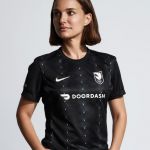
How Nike invested in women's football
Since 2019, the Swoosh has decided to invest more and more in the movement, and now ahead of the European Championships it is reaping the benefits
July 4th, 2022
For years, women’s football was looked down upon or even ignored by many fans of the male game, considered inferior and not worthy of their time. Even the treatment of the athletes by football federations and governing bodies reflected this perception. Although this view has not yet been eradicated and there is still a very long way to go before it reaches parity with the men’s game, there have been positive signs for women’s football over the last few years.
Progress has been made in terms of improved treatment by football authorities, increased attendances at matches, more media coverage and an unmistakable growth in popularity. The recent announcement that Women’s Serie A will turn fully professional from the 1st of July is proof of this, as is the setting of new match attendance records, something that’s happened twice already in 2022.
This increased attention is not coming only from the fans. Back in 2019, Nike made the decision to rethink their strategy for the football market. An interesting move, given that they were in a healthy position at the top of the game, with many of football’s best individual talents contracted to the brand. A shift in objectives saw them allow many players’ contracts to expire, letting their competitors swoop in and sign up these free agents. Puma made the most of the opportunity, giving deals to the likes of Jorginho, Raphael Varane and Neymar, while others signed with adidas and New Balance.
Of course Nike kept many top players in their stable, but in reducing their spending on these contracts, they were able to invest more in women’s football and grant it more focus in their marketing campaigns. According to Amy Montagne, VP, GM of Global Categories at Nike, 2019 was a “tipping point for women’s football”. The first statement they made in this regard was creating bespoke kits for 14 of the nations competing at the 2019 Women’s World Cup. Prior to this, most sides had always received the same basic design as the men’s teams, with a fit tailored to the female body. Instead, the kits for that year’s World Cup were the result of consultation with players, testing of different fits, 4D body scanning and the incorporation of unique patterns and designs for each jersey. Never before had Nike given so much consideration to the gear worn by female players.
Since then, the trend has continued. In most European domestic leagues, the majority of women’s teams are part of well-known clubs who have a pre-existing mens’ team, Juventus, AC Milan, Chelsea and Barcelona for example. In these cases, it is perhaps normal that the shirts worn by both the male and female teams carry the same design, as they play for the same club and share an identity to a certain extent. However, when it comes to kit launches and photoshoots, representation has become a lot more balanced. Athletes from the women’s team are now front and centre with the men. Swedish striker Ada Hegdeberg was made the face of the latest Nike Mercurial, alongside Cristiano Ronaldo, and a look at Nike’s Instagram showcases perfectly the increased presence of female athletes in their campaigns.
Across the Atlantic in the USA, the football landscape is slightly different. Nike have sponsored the top women’s league, the NWSL, since its inception in 2012, renewing that agreement in 2019. Due to the relative youth and constant growth of the sport over there, rather than established clubs having a women’s side, many new standalone women’s clubs have been formed. For these clubs, cultivating an identity is a major key to their success as a football club and a business, and Nike are giving a helping hand in that area. These young clubs receive beautifully designed kits, incorporating elements of local culture, team names and core values, all embossed with the Swoosh.
Portland Thorns home and away kits from 2020 attracted a huge amount of attention online, thanks to their complimentary rose-based designs - the home shirt featured a flower graphic, while the away bore the thorns that give the club its name. Racing Louisville received another beautiful floral design, laying a white lily print over a black shirt, with the carpel of the lilies coloured purple. Los Angeles’ first women’s team, Angel City, are currently playing their debut season in the NWSL wearing two kits bearing graphics inspired by the LA sunrise and the palm trees associated with the city. Orlando Pride’s 2022 away kit has a lunar theme, a nod to the Kennedy Space Centre, with the moon and its orbital rings being the central design elements. These are just a few examples of the attention to detail Nike affords to their women’s teams in the USA. These club-specific touches create a culture of expectancy for every new kit release and aid the clubs’ quest for a strong identity, as well as making people sit up and take notice.
With the next big event on the horizon being Women’s Euro 2022, Nike have once again delivered. France, the Netherlands and England each received a new set of home and away kits. Each nation received one simple but elegant design, and one more eye-catching, experimental shirt. France saw a reversion to the royal blue of years gone by, with a mesmerizing floral print referencing neoclassical architecture. England’s home shirt was given an iridescent paint job, with a geometrical pattern grabbing the attention when caught under the right lighting. For the Netherlands away jersey, Nike took the national flag's colors and applied them in an abstract manner to give the shirt a unique look.
These shirts, as well as those of the aforementioned American clubs and 2019 World Cup teams, are also available to buy in men’s sizes and fits. A smart move from Nike in a business sense but also one that was long overdue from an egalitarian point of view, as the reverse of this has been the case for years. As women’s football continues to develop and break into the mainstream, we can expect Nike’s involvement and support to grow alongside it. Don't be surprised to see other brands ramp up their interest in the coming years, too. This mutually beneficial relationship is producing results that everyone can enjoy.








































.png)


.jpg)


.png)
.jpg)
.jpg)
.jpg)
.jpg)










